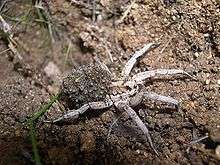Lycosa tarantula
| Lycosa tarantula | |
|---|---|
 | |
| Scientific classification | |
| Kingdom: | Animalia |
| Phylum: | Arthropoda |
| Class: | Arachnida |
| Order: | Araneae |
| Family: | Lycosidae |
| Genus: | Lycosa |
| Species: | L. tarantula |
| Binomial name | |
| Lycosa tarantula (Linnaeus, 1758) | |
| Synonyms | |
| |

Lycosa tarantula is the species originally known as the tarantula, a name that nowadays commonly refers to spiders in another family entirely, Theraphosidae. It now may be better called the tarantula wolf spider, being in the wolf spider family, the Lycosidae. Lycosa tarantula is a large species found in southern Europe, especially in the Apulia region of Italy and near the city of Taranto, from which it gets its name.[1]
Historical superstition has it that the spider's bite can produce severe symptoms called tarantism.
Description
These spiders are rather large, the females being as large as 30 mm (1.18 in.) in body length[2] and the males around 19 mm (0.75 in.). As with other wolf spiders, the silken sac containing over one hundred eggs is carried attached to the mother's spinnerets, and then after they hatch the baby spiders climb on their mother's abdomen and ride around with her for some time until they are sufficiently mature to survive on their own.[2] (The picture that accompanies this article shows a mother transporting her large brood.) After leaving their mother's protection, the young spiders disperse and dig burrows. Females live in their burrows all their lives except for nocturnal forays to capture prey,[2] but the mature males leave the protection of burrows and wander about looking for mates. The males can live for two years, and they die some time after reaching sexual maturity. The females can live for four years or more. During the winter these spiders hibernate in their burrows.
They are a nocturnal species and generally lurk at the mouths of their burrows waiting for prey, so it is unlikely that people would encounter them. Unlike the Salticidae (Jumping spiders), which may exhibit curiosity about humans and may be content to wander around on one's hand, the Lycosidae (wolf spiders) have a very strong tendency to flee at the approach of any large animal. They have quite good eyesight, so it is unlikely that a human could approach them unseen, and it is relatively difficult to capture them because they keep moving and can run very fast. It is unlikely that humans could come in unintentional contact with them. When wolf spiders are cornered, they show no inclination to make threat displays, much less to advance on a human's hand with the intention of biting.
Tarantism
It has been at one time a traditional belief among Apulian peasantry that a person bitten by one of these spiders must be treated by indulging in a special kind of dancing. The dance, or some version of it, is now known as the tarantella. In fact, however, the bites of this spider are not known to cause severe symptoms in humans, much less endanger human life.[3]
Venom
In common with all other spiders (except the Uloboridae) Lycosa tarantula possess venom. Venom is important to the spider as a means to kill its prey, and, secondarily, to protect itself. Evolutionarily, the venoms were tailored for subduing insect prey, and mammal species can have vastly different reactions to the same spider venom. Lycosa tarantula will rarely bite, unless continually provoked, and the venom of the Lycosidae is not particularly toxic to human beings, and is no more painful than the sting of a bee. Fabre however, did demonstrate that an artificially administered tarantula bite can kill small mammals and birds.[3]
Given the low toxicity of wolf spider bites and the small likelihood of actually being bitten, medical research efforts have not been directed toward the bites of Lycosa tarantula.
Subspecies
- Lycosa tarantula carsica (Caporiacco, 1949) — Italy
- Lycosa tarantula cisalpina Simon, 1937 — France
Notes
- John Crompton, The Life of the Spider, Mentor, 1954. pp. 56–57.
References
- ↑ The American Heritage Dictionary, 4th Ed.(2009), Publisher: Houghton Mifflin Company. "[Medieval Latin, from Old Italian tarantola, after Taranto.]"
- 1 2 3 Foelix, Rainer F. (2010). Biology of spiders (3rd ed.). Oxford: Oxford University Press. pp. 8–9. ISBN 0199734828.
- 1 2 Fabre,Jean-Henri; Translated by Alexander Teixeira de Mattos; The Life of the spider;Pub: Dodd, Mead, New York,1916. Download from: https://archive.org/details/lifespider00fabrgoog
External links
| Wikimedia Commons has media related to Lycosa tarantula. |
| Wikispecies has information related to: Lycosa tarantula |
- Lycosa tarantula at the Encyclopedia of Life

- Sexual Cannibalism: High Incidence in a Natural Population with Benefits to Females